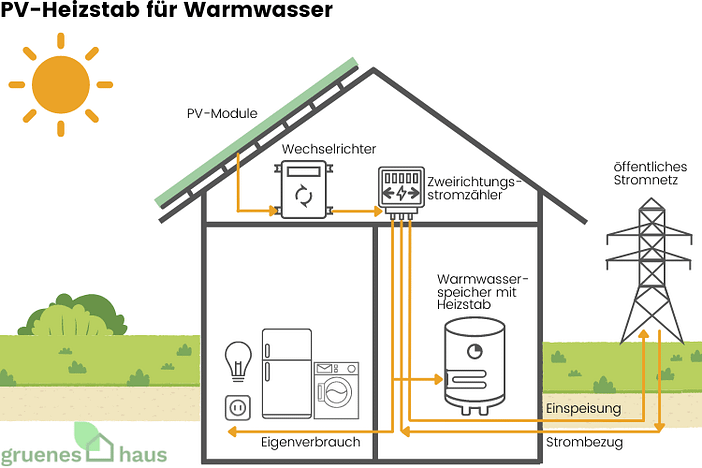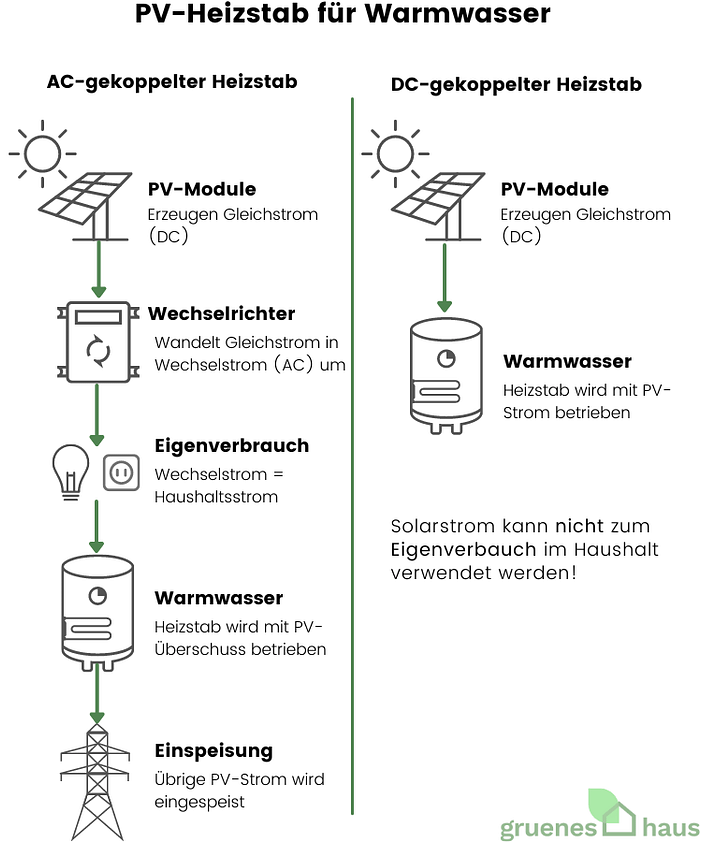Hot water with photovoltaics & heating element: advantages and disadvantages, costs
A PV system is primarily intended to cover the electricity demand. But it can do much more. Hot water preparation using photovoltaics in combination with a PV heating element is a sensible way to increase self-consumption. You can find out everything you need to know about it here.
First things first
What is a PV heating element?
A PV heating element uses solar power to efficiently heat water in hot water tanks, reducing energy costs.
How much does it cost?
A photovoltaic heating element for hot water costs €100 to €200. They also need a hot water tank.
What are the benefits?
The biggest advantages are the favorable price and easy installation of the PV heating element.
How many kW?
For PV systems up to 6 kWp, a heating element with 2 kW is sufficient. For larger system, at least 3 kW.
What is a PV heating element for hot water and how does it work?
A PV heating element for hot water is a component that generates heat using electrical energy. In this case, the PV heating element is the central element for hot water preparation. For this purpose, it is installed in a hot water tank and heats the drinking water it contains.

Hot water with photovoltaics and heating element
The PV heating element works like an immersion heater. It is also used in kettles and pool heaters. The central element is called the heating coil. It is heated by electricity and releases the heat to the water.
It is important for economical operation that the PV heating element only uses surplus electricity. In addition, the hot water temperature should ideally be between 50 and 55 °C. Ideally, 60 °C should not be exceeded, otherwise the hot water heating will consume too much electricity.
Can I connect a heating element directly to a PV system?
It is possible to connect the heating element directly to the PV system. To do this, the heating element must work with direct current. The combination eliminates the need to install an inverter, as the heating element directly consumes the self-generated solar power. You only need the PV modules and DC cabling. The system is the simplest way to heat water with solar energy.

Integration of the heating element in AC and DC operation
When does a heating element with photovoltaics make sense?
A heating element with photovoltaics only makes sense if the levelized cost of electricity is significantly lower than the price of electricity. Since the feed-in tariff has also fallen significantly, self-consumption of solar power is currently much more worthwhile. A heating element with photovoltaics is a sensible way to increase self-consumption. For every kilowatt hour you generate yourself that you use for your own consumption, you save up to 30 cents.
- Levelized cost of electricity: 3 to 10 cents per kWh
- Electricity price: 30 to 40 cents per kWh
- Feed-in tariff: 8.2 cents per kWh for surplus feed-in and 13 cents per kWh for full feed-in
For older PV systems with high feed-in tariffs, hot water heating from heating rods with photovoltaics is rather less worthwhile.
How much does a photovoltaic heating element for hot water cost?
A photovoltaic heating element for hot water costs €100 to €200. For efficient operation, you should also purchase an energy manager. This costs around €1,000. To cover the average hot water requirement, you need a PV system with 2 to 5 kWp. This costs €4,000 to €9,000.
| Cost center | Cost |
|---|---|
| Photovoltaic heating element | 100 - 200 € |
| Hot water tank (if not already available) | €1,000 - €3,000 |
| Energy Manager | €1,000 |
| PV system with 2 to 5 kWp | €4,000 - €9,000 |
How economical is a PV heating element?
If the heating element is ideally integrated into a PV system, it is possible to cover 100 percent of the hot water requirement. Since the levelized cost of electricity is far below the price of electricity, you save up to 70% of the annual electricity costs for hot water heating.
The table below compares the costs of operating a heating element - with electricity from the grid and with a PV system.
| Parameter | Hot water with heating element | Heating element with photovoltaics |
|---|---|---|
| Annual hot water demand | 3,000 kWh | 3,000 kWh |
| Historical cost | €3,000 | 9.000 € |
| Electricity | €0.30/kWh | - |
| Annual grid procurement costs | 900 € | - |
| PV yield | - | 3,000 kWh |
| Levelized cost of electricity | - | €0.10/kWh |
| annual levelized cost of electricity | - | 300 € |
| jährliche Einsparung | - | 600 € |
Welche Arten von Heizstäben gibt es?
Es gibt Heizstäbe für Warmwasserspeicher und -boiler. Diese sind meist in einer typischen U-Form aufgebaut. Was die Heizstäbe unterscheidet, ist die Regelung. Manche haben nur eine Ein-/Aus-Funktion, andere besitzen eine Stufenregelung. PV-Heizstäbe sollten stufenlos regelbar sein und ihre Leistung an den jeweiligen Bedarf anpassen. In Verbindung mit einem Energiemanager erreichen PV-Heizstäbe eine 100-prozentige Deckungsquote.
Steuerung optimieren mit einem Energiemanagementsystem
Ein Energiemanagementsystem (EMS) überwacht und optimiert den Energieverbrauch für maximale Leistung bei minimalen Kosten, insbesondere für den Betrieb einer eigenen Photovoltaikanlage. Besonders, wenn Sie Warmwasser mit Photovoltaik und Heizstab erzeugen, ist ein EMS wichtig. Dadurch können Sie wählen, welche elektrischen Verbraucher zuerst Strom erhalten oder Vorrang haben. Für die Warmwasserbereitung sollten Sie nur überschüssigen Solarstrom nutzen.
Energiemanagementsysteme bieten eine benutzerfreundliche App für Smartphones und Tablets.
Wie viel kW sollte der PV-Heizstab haben?
PV-Anlagen bis zu 6 kWp benötigen einen Heizstab mit 2 kW. Anlagen mit über 6 kWp benötigen mindestens 3 kW. Kleinere Heizstäbe können Sie an eine Haushaltssteckdose anschließen. Größere Modelle (3 kW und mehr) benötigen einen mehrphasigen Anschluss und eine zusätzliche Absicherung.
Wie viel Strom verbraucht ein Photovoltaik-Heizstab?
Ein Photovoltaik-Heizstab verbraucht 46,5 Wh pro Liter. Erwärmen Sie 200 Liter Wasser von 10 auf 50 °C, werden etwa 9,3 kW benötigt. Pro Personen benötigen Sie täglich 50 Litern an Warmwasser. Das entspricht einem jährlichen Stromverbrauch von 600 bis 800 kWh Strom pro Person für die Warmwasserbereitung. Umgerechnet sind es 1,65 bis 2,2 kWh pro Tag pro Person.
Kann ich einen Photovoltaik-Heizstab nachrüsten?
Sie können einen Photovoltaik-Heizstab unkompliziert nachrüsten. Wenn Sie bereits einen Warmwasserspeicher haben, ist die Nachrüstung einfach. Diese Speicher werden werkseitig mit einer Vorrichtung für den Einsatz eines Heizstabs ausgestattet.
Was sind die Vor- und Nachteile der Warmwassererzeugung mit Photovoltaik und Heizstab?
Ein PV-Heizstab ist eine tolle Möglichkeit, den Eigenverbrauch einer PV-Anlage zu steigern und die Energiekosten zu reduzieren. Alle Vor- und Nachteile finden Sie in der Übersicht.
| Vorteile Photovoltaik und Heizstab | Nachteile Photovoltaik und Heizstab |
|---|---|
| geringe Anschaffungskosten des Heizstabes | PV-Anlage muss ausreichend groß sein |
| Easy installation | Hot water tank entails acquisition costs |
| suitable for retrofitting | Hot water tank is necessary and requires a parking space |
| increases self-consumption | |
| Reduces energy costs | |
| Environmentally friendly and sustainable |
Compare PV offers and save up to 30%
Fill out the form below and receive up to five offers from qualified and certified specialist companies for photovoltaics in your region - free of charge and without obligation. It only takes two minutes. By comparing them, you can save up to 30% on your purchase.
Post a Comment for "Hot water with photovoltaics & heating element: advantages and disadvantages, costs"